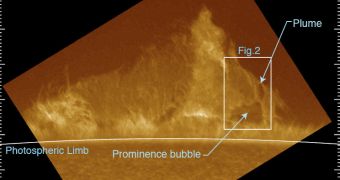An in-depth study of the activity going on on the surface of the Sun has revealed an interesting aspect of how powerful solar storms form. According to researchers, it would appear that giant bubbles of plasma, superheated at high temperatures, are responsible for fueling the events.
Understanding the physics behind solar flares is tremendously important for experts in charge of monitoring space weather, or the effects that the Sun causes on the planets around it.
If the material ejected from the star's surface during such an event is aimed at our planet, then we need to take measures to ensure we are protected. The highly-energetic particles can damage power lines, fry electronics equipment aboard satellites, and endanger the crew on the International Space Station.
But we already have a relatively large number of Sun-monitoring satellites in space, which keep an eye on solar activity, and warn us about such an eruption taking place. Such a spacecraft was recently able to identify the role the plasma bubbles play in generating the solar storms.
At first, these bubbles were noticed rising through the solar atmosphere. Astrophysicists then saw them uniting with magnetic ropes and electrical currents high above the solar surface, and these interactions are what caused a coronal mass ejection (CME) to be triggered.
More thorough, advanced research in this field could “perhaps establish a predictive tool for the eruption of CME based on the rate of observed [magnetic] flux injection,” explains Thomas Berger.
The expert holds an appointment at the Palo Alto, California-based Lockheed Martin Solar and Astrophysics Laboratory. He is also the lead author of a new research paper describing the findings.
In order to conduct the study, the expert and his team combined data collected by the NASA Solar Dynamics Observatory (SDO) with information obtained by the Hinode spacecraft. The latter is built and operated by the Japan Aerospace Exploration Agency (JAXA).
The spacecraft determined that the plasma bubbles are “analogous to the blobs of material in a lava lamp that are heated by a light from below, become buoyant, and rise to the top to deposit their energy, then drop back down again,” Berger explains, quoted by Space.
In the new study, the research team determined that the bubbles had an average temperature of at least 250,000 degrees Celsius (450,000 degrees Fahrnheit). However, top temperatures exceeded 1 million degrees Celsius (1.8 million degrees Fahrenheit).

 14 DAY TRIAL //
14 DAY TRIAL //